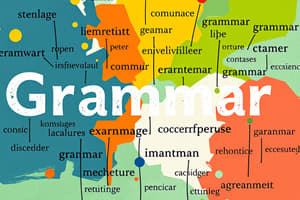Podcast
Questions and Answers
Which language family does English belong to?
Which language family does English belong to?
- Celtic
- Slavic
- Germanic (correct)
- Romance
What is the common sentence structure in English?
What is the common sentence structure in English?
- Subject-Object-Verb
- Object-Subject-Verb
- Subject-Verb-Object (correct)
- Verb-Subject-Object
Which of the following is a notable author of English literature?
Which of the following is a notable author of English literature?
- Leo Tolstoy
- Gabriel Garcia Marquez
- Mark Twain (correct)
- Haruki Murakami
What is the primary medium for much of global media and science?
What is the primary medium for much of global media and science?
Which period of English followed Old English?
Which period of English followed Old English?
Flashcards are hidden until you start studying
Study Notes
English Language Overview
- Definition: English is a West Germanic language originating in medieval England.
- Global Status:
- Widely spoken around the world.
- Official language in about 58 countries.
- Primary language of international business, science, technology, and aviation.
Language Family
- Part of the Germanic branch of the Indo-European language family.
- Divided into three main periods:
- Old English (450-1150)
- Middle English (1150-1500)
- Modern English (1500-present)
Phonetics and Phonology
- Vowels: English has around 12-14 vowel sounds, varying by dialect.
- Consonants: Includes 24 consonant sounds, unique features like 'th' sounds (/θ/ and /ð/).
Grammar
- Parts of Speech:
- Nouns, Pronouns, Verbs, Adjectives, Adverbs, Prepositions, Conjunctions, Interjections.
- Sentence Structure: Commonly follows Subject-Verb-Object (SVO) order.
- Tenses: English uses a variety of tenses to indicate time.
Vocabulary
- Influenced by multiple languages (Latin, French, Norse).
- Contains a large number of synonyms and varies in register (formal vs. informal).
Dialects and Variations
- Major dialects include:
- British English
- American English
- Australian English
- Indian English
- Variations in pronunciation, spelling, and vocabulary.
Writing System
- Uses the Latin alphabet with 26 letters.
- Conventions include:
- Capitalization rules.
- Punctuation marks (periods, commas, question marks).
Literature
- Key works span from Beowulf (Old English) to contemporary novels.
- Notable authors: William Shakespeare, Jane Austen, Mark Twain, and Toni Morrison.
Usage in Society
- English is often a lingua franca in multicultural environments.
- Primary medium for much of global media, science, and literature.
Learning English
- Commonly taught worldwide as a second language.
- Different methods include immersive, grammar-focused, and communicative approaches.
English Language Overview
- English is part of the West Germanic branch of the Indo-European language family.
- English is spoken globally and is the official language in about 58 countries.
- It is the primary language of international business, science, technology, and aviation.
Language Family
- English has three main periods: Old English (450-1150), Middle English (1150-1500), and Modern English (1500-present).
Phonetics and Phonology
- English has around 12-14 vowel sounds and 24 consonant sounds.
- English has unique features like 'th' sounds (/θ/ and /ð/).
Grammar
- English uses the Subject-Verb-Object (SVO) sentence structure.
- It has a variety of tenses, including past, present, and future tenses.
Vocabulary
- English vocabulary has been influenced by languages such as Latin, French, and Norse.
- English has a large number of synonyms and varies in register, with formal and informal styles.
Dialects and Variations
- Major dialects include British English, American English, Australian English, and Indian English.
- Dialects vary in pronunciation, spelling, and vocabulary.
Writing System
- English uses the Latin alphabet with 26 letters.
- English writing conventions include capitalization rules and punctuation marks such as periods, commas, and question marks.
Literature
- English literature spans from Old English works like Beowulf to contemporary novels.
- Notable English authors include William Shakespeare, Jane Austen, Mark Twain, and Toni Morrison.
Usage in Society
- English is often the lingua franca in multicultural environments.
- English is the primary medium for much of global media, science, and literature.
Learning English
- English is frequently taught worldwide as a second language.
- Learning methods include immersive, grammar-focused, and communicative approaches.
Studying That Suits You
Use AI to generate personalized quizzes and flashcards to suit your learning preferences.




